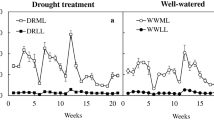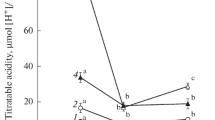Abstract
Key message
In rupestrian savannas in southeastern Brazil Clusia arrudae Planchon & Triana in the dry season performed CAM-cycling with very little gas exchange in the early morning followed by a long depression during the rest of the day. CAM-cycling is considered as a survival strategy under drought and the productivity of the plant which is quite abundant must rely on performance of C 3 -photosynthesis in more favorable seasons.
Abstract
In rupestrian savannas in the Serra do Cipó (19°14′48.9″S, 43°30′36.0″W) at 1300 m a.s.l. and in the Serra de São José (21°08′S, 44°17′W) at 1010–1030 m a.s.l. in southeastern Brazil Clusia arrudae Planchon & Triana is abundant. As CAM is frequent in the genus Clusia we supposed that it would perform CAM as a drought adaptation at the very dry rupestrian savanna sites in the dry season. At the Serra do Cipó site as control we studied the obligate C3-species Eremanthus glomerulatus Less. Both species are sympatric at this site. Eremanthus glomerulatus performed C3-photosynthesis with a midday depression. The patterns of C. arrudae were completely different so that genuine C3-photosynthesis was excluded, but they were also not typical of CAM. The stomata were almost closed during the night. Some stomatal opening and net CO2 uptake occurred in the early morning hours followed by a long depression with stomatal closure throughout the rest of the day. Nevertheless, photo inhibition was limited and photosynthetic electron transport rate remained high during this time indicating that photosynthetic excitation energy was required and suggesting that CO2 assimilation was continuing behind closed stomata based on internal sources of CO2. There was some nocturnal accumulation of organic acids (malic and citric acids) which could represent a source of CO2 during the light period. Overall, the observations can be best explained by the performance of CAM-cycling by C. arrudae. However, leaf carbon gain of C. arrudae was much inferior to that of E. glomerulatus. CAM-cycling appears to be a strategy for protection from photoinhibitory damage and survival under strong conditions of drought. Steeper more vertical leaf positions observed would assist reducing overheating during stomatal closure at high irradiance. The abundance of C. arrudae suggests that the plant must have other means to sustain productivity such as full C3-photosynthesis in the more favorable seasons.








Similar content being viewed by others
References
Alves RJV (1991) Field guide to the orchids of Serra de São José. Tropica leaf, Prague
Bilger W, Schreiber U, Bock M (1995) Determination of quantum efficiency of photosystem II and of non-photochemical quenching of chlorophyll fluorescence in the field. Oecologia 102:425–432
Bittrich V, Amaral MCE (1997) Floral biology of some Clusia species from Central Amazonia. Kew Bull 52:617–635
Björkman O, Demmig B (1987) Photon yield of O2 evolution and chlorophyll fluorescence characteristics at 77 K among vascular plants of diverse origins. Planta 170:489–504
De Mattos EA (1998) Perspectives in comparative ecophysiology of some Brazilian vegetation types: leaf CO2 and H2O gas exchange, chlorophyll a fluorescence and carbon isotope discrimination. In: Scarano FR, Franco AC (eds) Ecophysiological strategies of xerophytic and amphibious plants in the neotropics. Oecologia Brasiliensis, vol IV. Universidade Federal do Rio de Janeiro, Rio de Janeiro, pp 1–22
De Mattos EA, Lobo PC, Joly CA (2002) Overnight rainfall inducing rapid changes in photosynthetic behaviour in a cerrado woody species during a dry spell amidst the rainy season. Aust J Bot 50:241–246
Demmig-Adams B, Adams WW, Barker DH, Logan BA, Bowling DR, Verhoeven AS (1996) Using chlorophyll fluorescence to assess the fraction of absorbed light allocated to thermal dissipation of excess excitation. Physiol Plant 98:253–264
Falster DS, Westoby M (2003) Leaf size and angle vary widely across species: what consequences for light interception? New Phytol 158:509–525
Franco AC (1998) Seasonal patterns of gas exchange, water relations and growth of Roupala montana, an evergreen savanna species. Plant Ecol 136:69–76
Franco AC (2002) Ecophysiology of woody plants. In: Oliveira PS, Marquis RJ (eds) The cerrados of Brazil: ecology and natural history of a neotropical savanna. Columbia University Press, New York, pp 178–197
Franco AC, Lüttge U (2002) Midday depression in savanna trees: coordinated adjustments in photochemical efficiency, photorespiration, CO2 assimilation and water use efficiency. Oecologia 131:356–365
Franco AC, Ball E, Lüttge U (1992) Differential effects of drought and light levels on accumulation of citric and malic acids during CAM in Clusia. Plant Cell Environ 15:821–829
Franco AC, Matsubara S, Orthen B (2007) Photoinhibition, carotenoid composition and the co-regulation of photochemical and non-photochemical quenching in neotropical savanna trees. Tree Physiol 27:717–725
Giulietti AM, Pirani JR (1988) Patterns of geographic distribution of some plant species from the Espinhaço range, Minas Gerais and Bahia, Brazil. In: Vanzolini PE, Heyer WR (eds) Proceedings of a workshop on neotropical distribution patterns. Academia Brasileira de Ciências, Rio de Janeiro, pp 39–69
Grams TEE, Herzog B, Lüttge U (1998) Are there species in the genus Clusia with obligate C3-photosynthesis? J Plant Physiol 152:1–9
Herzog B, Grams TEE, Haag-Kerwer A, Ball E, Franco AC, Lüttge U (1999) Expression of modes of photosynthesis (C3, CAM) in Clusia criuva Camb. in a cerrado/gallery forest transect. Plant Biol 1:357–364
Hohorst HG (1965) L-(−)-Malat. Bestimmung mit Malatdehydrogenase und NAD. In: Bergmeyer HU (ed) Methoden der enzymatischen Analyse, vol 2, 2nd edn. VCH, Weinheim, pp 1544–1548
Lüttge U (1999) One morphotype, three physiotypes: sympatric species of Clusia with obligate C3 photosynthesis, obligate CAM and C3-CAM intermediate behaviour. Plant Biol 1:138–148
Lüttge U (2000) Photosynthese-Physiotypen unter gleichen Morphotypen, Species und bei Klonen: kann ökophysiologische Plastizität zur Entstehung von Diversität beitragen? Ber Reinh Tüxen Ges 12:319–334
Lüttge U (2004) Ecophysiology of crassulacean acid metabolism (CAM). Ann Bot 93:629–652
Lüttge U (2007a) Photosynthesis. In: Lüttge U (ed) Clusia, a woody neotropical genus of remarkable plasticity and diversity. Springer, Heidelberg, pp 135–186
Lüttge U (2007b) Physiological Ecology. In: Lüttge U (ed) Clusia, a woody neotropical genus of remarkable plasticity and diversity. Springer, Heidelberg, pp 187–234
Lüttge U (2008) Physiological ecology of tropical plants, 2nd edn. Springer, Heidelberg
Lüttge U, Duarte HM (2007) Morphology, anatomy, life-forms and hydraulic architecture. In: Lüttge U (ed) Clusia, a woody neotropical genus of remarkable plasticity and diversity. Springer, Heidelberg, pp 17–30
Lüttge U, Duarte HM, Scarano FR, de Mattos EA, Cavalin PO, Franco AC, Fernandes GW (2007) Physiological ecology of photosynthesis of five sympatric species of Velloziaceae in the rupestrian fields of Serra do Cipó, Minas Gerais, Brazil. Flora 202:637–646
Lüttge U, Scarano FR, de Mattos EA, Franco AC, Broetto F, Dias ATC, Duarte HM, Uehlein N, Wendt T (2015) Does ecophysiological behaviour explain habitat occupation of sympatric Clusia species in a Brazilian Atlantic rainforest? Trees 29:1973–1988
Madeira JA, Fernandes GW (1999) Reproductive phenology of sympatric species of Chamaecrista (Leguminosae) in Serra do Cipó. Brazil J Trop Ecol 15:463–479
Martin CE (1996) Putative causes and consequences of recycling CO2 via crassulacean acid metabolism. In: Winter K, Smith JAC (eds) Crassulacean acid metabolism: biochemistry, ecophysiology and evolution. Springer, Heidelberg, pp 192–203
Möllering H (1985) Citrate. determination with citrate lyase, MDH and LDH. In: Bergmeyer HU (ed) Methods of enzymatic analysis. Academic Press, New York, pp 2–12
Moraes JAPV, Prado CHBA (1998) Photosynthesis and water relations in cerrado vegetation. In: Scarano FR, Franco AC (eds) Ecophysiological strategies of xerophytic and amphibious plants in the neotropics. Oecologia Brasiliensis, vol IV. Universidade Federal do Rio de Janeiro, Rio de Janeiro, pp 45–63
Oliveira-Filho AT, Ratter JA (2002) Vegetation physiognomies and woody flora of the Cerrado Biome. In: Oliveira PS, Marquis RJ (eds) The cerrados of Brazil: ecology and natural history of a neotropical savanna. Columbia University Press, New York, pp 91–120
Osmond CB (1978) Crassulacean acid metabolism: a curiosity in context. Ann Rev Plant Phys 19:379–414
Pereira MCA (1994) Estrutura das comunidades vegetais de afloramentos rochosos dos campos rupestres do Parque Nacional da Serra do Cipó, MG. MSc Thesis, Universidade Federal de Minas Gerais, Belo Horizonte
Rascher U, Liebig M, Lüttge U (2000) Evaluation of instant light-response curves of chlorophyll fluorescence parameters obtained with a portable chlorophyll fluorometer on site in the field. Plant Cell Environ 23:1397–1405
Scarano FR (2002) Structure, function and floristic relationships of plant communities in stressful habitats marginal to the Brazilian Atlantic rainforest. Ann Bot 90:517–524
Scarano FR, Duarte HM, Franco AC, Geβler A, de Mattos EA, Nahm M, Rennenberg H, Zaluar HLT, Lüttge U (2005) Ecophysiology of selected tree species in different plant communities at the periphery of the Atlantic Forest of SE—Brazil. I. Behaviour of three different species of Clusia in an array of plant communities. Trees 19:497–509
Schreiber U, Bilger W (1993) Progress in chlorophyll fluorescence research: major developments during the last years in retrospect. Progr Bot 54:151–173
Silva AC, Vidal-Torrado P, Cortizas AM, Rodeja EG (2004) Solos do topo da Serra de São José (Minas Gerais) e suas relações com o paleoclima no sudeste do Brasil. R Bras Ci 28:455–466
Sipes DL, Ting IP (1985) Crassulacean acid metabolism and crassulacean acid metabolism modifications in Peperomia camptotricha. Plant Physiol 77:59–63
Smith JAC, Lüttge U (1985) Day-night changes in leaf water relations associated with the rhythm of crassulacean acid metabolism in Kalanchoë daigremontiana. Planta 163:272–282
Tenhunen JD, Lange OL, Braun M (1981) Midday stomatal closure in Mediterranean type sclerophylls under simultaed habitat conditions in an environmental chamber II. Effect of the complex of leaf temperature and air humidity on gas exchange of Arbutus unedo and Quercus ilex. Oecologia 50:5–11
Ting IP (1985) Crassulacean acid metabolism. Ann Rev Plant Physiol 36:595–622
Veste M, Herppich WB, von Willert DJ (2001) Variability of CAM in leaf-deciduous succulents from the Succulent Karoo (South Africa). Basic Appl Ecol 2:283–288
Acknowledgments
We thank three anonymous reviewers for valuable comments and corrections. We thank Volkswagen Stiftung, Germany, for funding and CNPq (Brazilian Research Council) for productivity Grants to FRS, EAM, ACF and GWF. Logistic support was provided by Parque Nacional da Serra do Cipó-IBAMA, Planta Tecnologia Ambiental and Reserva Particular Vellozia.
Author information
Authors and Affiliations
Corresponding author
Ethics declarations
Conflict of interest
The authors declare that they have no conflict of interest.
Additional information
Communicated by J. Peñuelas.
Rights and permissions
About this article
Cite this article
Scarano, F.R., de Mattos, E.A., Franco, A.C. et al. Features of CAM-cycling expressed in the dry season by terrestrial and epiphytic plants of Clusia arrudae Planchon & Triana in two rupestrian savannas of southeastern Brazil in comparison to the C3-species Eremanthus glomerulatus Less.. Trees 30, 913–922 (2016). https://doi.org/10.1007/s00468-015-1331-z
Received:
Revised:
Accepted:
Published:
Issue Date:
DOI: https://doi.org/10.1007/s00468-015-1331-z




